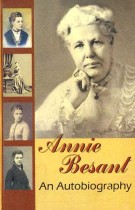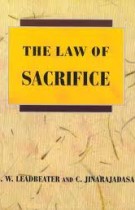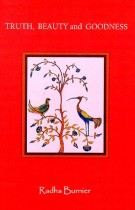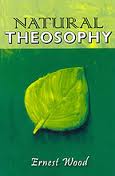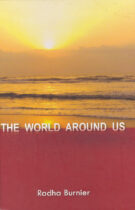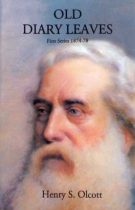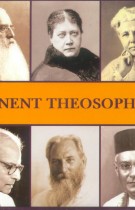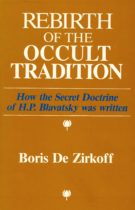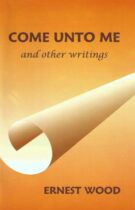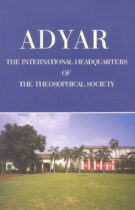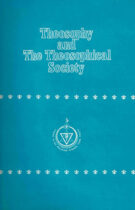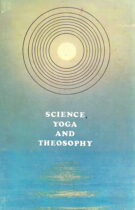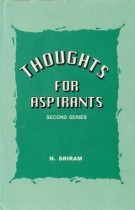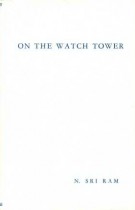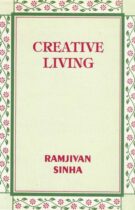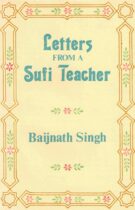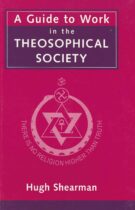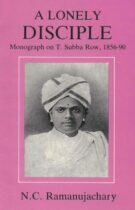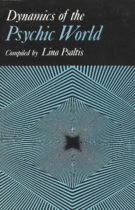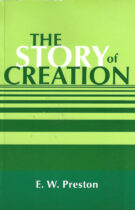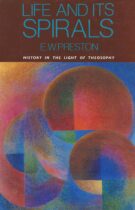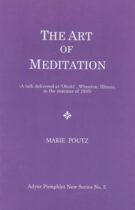An Autobiography
322 pages | Gebonden/Hardcover | Theosophical Publishing House, 2008
This book, first published in 1893, contains a candid description of the first forty-two years of Annie Besant’s life: a relatively happy childhood, an unfortunate marriage, followed by domestic, social, religious and political trials and tribulations. It reveals her remarkable courage and a strong sense of social justice.
This autobiography is a shining example of the unlimited potential of one who is convinced of his or her goal.
Annie Besant (1847-1933) led the fight for the rights of women and laborers in her native England; later she worked with Mahatma Gandhi and spearheaded India’s struggle for freedom. Theosophist Joy Mills describes her as “a feminist before the movement for women’s rights was fully launched; she stood for freedom when half the world was held in the bonds of colonialism.” A student of India’s spiritual traditions, Annie Besant was famed as an orator, author, and international President of the Theosophical Society.
Man, His Origins and Evolution
99 pages | Paperback | Theosophical Publishing House, 1961
Sri Ram
A series of talks given in 1951 and 1952 by a past international President of the Theosophical Society. Topics include: What Is Man?, Evolution of Man, The Subtle Nature of Man, Seeking, and Integrating Our Knowledge and Ourselves.
N. Sri Ram, was international President of the Theosophical Society for over 20 years, from 1953-73. He brings to his writings a background of eastern wisdom combined with keen awareness of modern thought and knowledge, as well as a sensitive understanding of human problems. His special felicity of style enables him to convey profound ideas in a lucid and absorbing manner.
The Human Interest
215 pages | Gebonden/Hardcover | Theosophical Publishing House, 1986
The Human Interest and Other Addresses and Short Essays
N. Sri Ram, was international President of the Theosophical Society for over 20 years, from 1953-73. He brings to his writings a background of eastern wisdom combined with keen awareness of modern thought and knowledge, as well as a sensitive understanding of human problems. His special felicity of style enables him to convey profound ideas in a lucid and absorbing manner.
Centred Self Without Being Self-Centred – Remembering Krishnamurti
20 Pages | First edition, 2010 | Paperback | Theosophical Publishing House, Adyar
Jiddhu Krishnamurti (1895 – 1986), like all true Rishis and Philosophers, based his saying on seeing. With him the emphasis was always on perception rather than thinking. Almost in every engagement – even in personal conversations this was often the case – sometimes practically in the middle of a sentence he would say, ‘Now listen to the birds‘ or ‘Look at the clouds‘. The mind which had been trapped in arguing or putting two and two together, would thus be invited to look. One was literally brought back to one’s senses.
“I was particularly moved by the scope, insight, and intimacy of this. I think you say things about Krishnamurti that are very true but not generally understood. I also think you go a long way to dispel some of the inevitable mythology that accrues, in time, to any teacher, mentor, or charismatic ‘religious’ figure. This is especially important as regards Krishnamurti. I realize how much there is in this and how truly wonderful it is.” — Alan Kishbaugh, the Executive Director of the Krishnamurti Foundation of America from 1998-2002 Excerpt: As Krishnamurti often emphasized, only a still mind can be attentive. There is a quality of attention and seeing which can bring about an action in oneself so that a radical change can take place naturally, from the inside. I once asked Krishnamurti about the nature of this attention, what he himself called total attention. I said to him, “What I find in myself is the fluctuation of attention.” He said with emphasis, “What fluctuates is not attention. Only inattention fluctuates.” For him, there was never a compromise with half-measures; it was a matter of total commitment to truth, or nothing at all. As long as one does not have a centered self, one is fragmented and agitated. Then one is inevitably self-centered because vastness, freedom and compassion cannot be available to a fragmented and disordered self. When one is centered, one naturally sees the limitation of the personal or selfish perspective. Then one naturally wishes to be free of the prison of selfishness. Until then, the notion or effort to be free of the self is merely an idea and a fantasy. When one has awakened senses, a clear heart and an alert mind, one can go beyond thought to an intelligence which is not so personal or self-bound.
The Law of Sacrifice
68 pages | Paperback | Theosophical Publishing House, 2000
C.W. Leadbeater and C. Jinarajadasa
Sacrifice is selfless giving, the way to freedom from the bondage of karma. “All nature must give forth or die”. The Eternal Principle gives of itself in manifestation this is the great Cosmic Sacrifice, which C. Jinarajadasa explains with quotations from ancient texts and living examples.
C.W. Leadbeater points out that sacrifice is “Love in the fullest and deepest sense of the word”. By giving ourselves in loving service, in unselfish devotion and renunciation for the good of others, we can transmute ourselves. Love is the way to life and immortality.
C. W. Leadbeater was a highly developed clairvoyant and the author of over thirty books on the spiritual life and on the psychic nature of man. He unfolded and perfected his own psychic faculties under the guidance of his Adept teacher and in 1893 began his clairvoyant investigations, on occasion collaborating with Annie Besant, the second President of the Theosophical Society. His worldwide lectures presented a new viewpoint to thousands of people. Other titles by the author C. W. Leadbeater: – The Chakras – Christian Gnosis – The Inner Life – Man, Visible and Invisible
Gods in Exile
118 pages | Paperback | Theosophical Publishing House, 1987
The way and power of the ego.
1926. A priest in the Liberal Catholic Church, Van Der Leeuw writes that the pages in this book are based on an awakening of Ego-consciousness that came to him in a single moment, but has taken days to realize and many pages to describe. Contents: The Drama of the Soul in Exile; The Way to the Ego; The World of the Ego; The Powers of the Ego; and The Return of the Exile.
An Adyar book, imported from India.
Buddhist Stories
Translated by Frank Lee Woodward (1871 – 1952).
140 Pages | First edition 1925, reprint 1994 | Softcover | Theosophical Publishing House, Adyar | ISBN: 8170592380.
The stories appearing in this book are translated from The Commentary on the Dhammapada. They were originally published in the Magazines The Young Citizen and The Adyar Bulletin. They illustrate the moral teachings of Buddhism in a simple and easy form.
F. L. Woodward was an authority on Buddhist teachings; many of his publications were published by the Pali Text Society, among them Pictures of Buddhist Ceylon, The Buddha’s Path of Virtue and Francis Bacon and the Cipher Story. He could be considered part of the noble band of Theosophists, who had worked for the revival of Buddhism in Sri Lanka under the leadership of Colonel Henry Steel Olcott (1832 – 1907).
From Chapter XXI – ‘This Little Body Holdeth All’ (p. 120):
” Not to be reached by going is world’s end.
Yet is there no release for man from woe,
Unless ye reach world’s end. Yea verily
He that is wise and lives the holy life,
He knows the world. He goeth to world’s end.
Calmed is he, for he knows. He hankereth
Neither for this world nor for any world. “
From: Anguttara Nikāya (ii., p. 46).
Truth, Beauty, and Goodness
81 pages | Paperback | Theosophical Publishing House, 2002
Truth, Beauty, and Goodness are interrelated. While beauty is the garment of truth, goodness is beauty revealed in action. Many philosophers and poets have spoken about the identity of these three aspects of reality, how each one leads to the other. Discovery of truth or beauty is the natural aspiration of every right thinking individual. Clarity and undisturbed serenity are essential requirements for perceiving truth. These qualifications cannot be acquired in the absence of pure and righteous living.
An Adyar book, imported from India.
Radha Burnier became 7th international President of the Theosophical Society in 1980, following the lead of her father, N. Sri Ram, who was the 5th President, and close associate of Annie Besant. Mrs. Burnier had previously served in many capacities, including Director of the research and publications of the Adyar Library and Research Centre from 1959-1979. She holds a Master’s degree in Sanskrit from the Benares Hindu University, and an honorary Doctor of Literature degree from Nagarjuna University. She has lectured all over the world on Theosophical and cultural topics, and both her talks and writings are known for their clarity of thought and depth of vision.
Natural Theosophy
158 pages | Gebonden/Hardcover | Theosophical Publishing House, 2008
This book shows us that Theosophy in its pristine form is very ancient and indicates the opposite of every kind of materialism, both scientific and religious. Theosophy or the Divine Wisdom belongs to the everyday world, nutured by our altruistic desires. Thought, Love or will applied to our daily experience reveals its divine value, leading us to find the infinite in the finite.
The Eastern concept of “satyam”, “sivam” and “sundaram” (truth, goodness and beauty) are fittingly interwoven into the triad of thought, will, and action.
This book will help the reader understanding more clearly the true nature of Theosophy.
Ernest Wood, scholar, writer, and lecturer, was born in 1883 in England and was attracted to Theosophy at a young age. He arrived in India early in the twentieth century, and assisted Annie Besant in educational work. He was the founder of the Theosophical College, Madanapalle. He wrote many books on philosophical subjects, having a particular interest in Yoga. After World War II, he came to the United States, where he was for several years Dean of the American Academy of Asian Studies in San Francisco and later joined the staff of the University of Houston, Texas. Other titles by the author: – Come Unto Me: And Other Writings – Concentration – Concentration: An Approach to Meditation – The Occult Training of the Hindus – The Seven Rays
Krishnamurti and the Wind: A Biography
By Jean Overton Fuller.
300 Pages | First published in 2003 | Paperback | Theosophical Publishing House London, 2003
Who was Krishnamurti? The Theosophists, basing themselves upon certain ancient India calculations os astronomical cycles, believed a new major spiritual teacher to be due, who would set the keynote of the new age, and that it was their job to find him, care for him until his maturity and prepare the way for him. In Jiddu Krishnamurti (1895 – 1986), spotted paddling off the beach near their headquarters in Adyar, they believed they had found him. Annie Besant (1847 – 1933) assumed his legal guardianship, and an Order was created for him to head. But on reaching maturity he dissolved the Order and the words he spoke were unlike those they expected to hear. Had he renounced his mission, or had they chosen the wrong boy, or was it a case of new wine bursting old bottles? New people came to hear him. The Dalai Lama, who does not commonly visit, visited Krishnamurti, and was said to ask, ‘Sir what do you believe?’ He does not tell us what answer he received , but says he found Krishnamurti ‘a Nagarjuna’. What did he mean?
From the Chapter ‘The Last Goodbye’ (p. 272):
The last tape of Krishnamurti dated 7 Feb. 1986:
” . . . for seventy years that super-energy – no – that immense energy, immense intelligence, has been using this body. I don’t think people realise what tremendous energy and intelligence went through this body – there’s a twelve cylinder energy . . . and now the body can’t stand any more. Nobody, unless the body has been prepared, very carefully protected . . . can understand what went through this body. Nobody. Don’t anybody pretend. Nobody, I repeat this: nobody amongst us or the public know what went on. I know they don’t. And now, after seventy years, it has come to an end. Not that intelligence and energy . . . it’s somewhere here, every day and especially at night . . .You won’t find another body like this, or that supreme intelligence operating in a body for many hundred years. You won’t see it again. When he goes, it goes.
There is no consciousness left behind of that consciousness, or that state. They’ll all pretend or try to imagine they can get into touch with that. Perhaps they will somewhat if they live the teachings. But nobody had done it. Nobody. And so that’s that. “
The World Around Us – ‘On The Watch-Tower’ Articles from 1980 – 2007
By Radha S. Burnier (1923 – 2013).
620 Pages | First edition 2009 | Hardcover | Theosophical Publishing House Adyar | ISBN: 9788170595212.
Mrs. Radha Burnier served five terms as the President of the Theosophical Society, having taken office as the seventh President in 1980. The World Around Us is a compilation of Burnier’s ‘On The Watch-Tower’ notes, which appeared as her editorial articles in The President’s official monthly Journal The Theosophist between the years 1980 and 2007. The validity and teachings of these articles continue to be appreciated by many members of the Theosophical Society around the world.
Mrs. Burnier’s careful observation and deep perception of the modern world and of human nature in general, sensitively guides the reader to a better understanding of the Theosophic life. The compilation provides a rich source of handy reference material and comments of Wisdom on a wide range of subjects – social, geographical, environmental, and spiritual, among others – that rouse the reader to a better awareness and involvement in the world around us.
From Chapter 1 – ‘Theosophy and the Theosophical Society’ (p. 10):
” No Wisdom from above descends on anyone save on leaving every atom of selfishness or desire for personal ends. Nature gives her innermost secrets and imparts true Wisdom only to him or her, who seeks truth for its own sake and craves for knowledge in order to confer benefits on others, not on his or her own unimportant personality. “
Radha Burnier became 7th international President of the Theosophical Society in 1980, following the lead of her father, N. Sri Ram, who was the 5th President, and close associate of Annie Besant. Mrs. Burnier had previously served in many capacities, including Director of the research and publications of the Adyar Library and Research Centre from 1959-1979. She holds a Master’s degree in Sanskrit from the Benares Hindu University, and an honorary Doctor of Literature degree from Nagarjuna University. She has lectured all over the world on Theosophical and cultural topics, and both her talks and writings are known for their clarity of thought and depth of vision.
Old Diary Leaves – Volume I, 1874-78
490 pages | Paperback | T.P.H. Adyar, India, 2002
Olcott tells of his association with his co-founder, Madame H.P. Blavatsky, and their work together for the cause of Theosophy. He writes of their contacts with the Mahatmas, of travels in many lands, and of the growth of The Theosophical Society from its small beginnings in New York in 1875 to an expanding international movement spread through many parts of the world.
To keep intact the true flavour of the early years of the Theosophical Society, Col. Olcott’s words are presented just as he wrote them .
His comments include references to occasional differences of opinion with his close and trusted colleague, H.P. Blavatsky. These very human differences perhaps will cause the reader to react with a smile of relief, knowing that great leaders such as these were also subject to human frailty and to times of disagreement. Old Diary Leaves gives a personal evaluation only, and is not intended to represent an official history of The Theosophical Society. Henry Steel Olcott was born on 2 August 1832 in Orange, New Jersey. In his early life he became distinguished in the field of agriculture, and then later for his services to the US Government during the Civil War. In 1874, when investigating spiritualistic phenomena for some New York newspapers, he met H.P.Blavatsky and together they became the principal founders of The Theosophical Society. He devoted the rest of his life to work for the Society and related causes. He died on 17 February, 1907 at Adyar, Madras ( now Chennai) , India.
Eminent Theosophists (CD-Rom)
CD Rom | T.P.H. Adyar, India, 2006
Helena Petrovna Blavatsky (1831–91) was perhaps the greatest Occultist of the West in recent times, and an outstanding messenger who presented the Ancient Wisdom for the modern age. With little fanfare she brought to bear powerful influences on human affairs, as is exemplified in her life and works. She did not bring anything new to mankind; in fact she succeeded in the great task of communicating wisdom that is as ancient as mankind.
Annie Besant (1847–1933), second President of The Theosophical Society from 1907 to 1933, was described as a ‘Diamond Soul’, for she had many brilliant facets to her character. She was an outstanding orator of her time, a champion of human freedom, educationist, philanthropist, and author with more than three hundred books and pamphlets to her credit.
Henry Steel Olcott (1832–1907), President-Founder of the Theosophical Society was born on 2 August 1832 at Orange, New Jersey. Olcott came from an old English Puritan family that had been settled for many generations in the United States.
C. Jinarājadāsa (1875–1953), the fourth President of the Theosophical Society, was educated at Cambridge University, England, and was an exceptional linguist, who lectured fluently in many European languages. His wide range of interests and writings included religion, philosophy, literature, art, science and occult chemistry. He made valuable sketches and notes during the clairvoyant investigations of Annie Besant and C. W. Leadbeater into the structure of matter.
Charles Webster Leadbeater (1847–1934) was a highly developed clairvoyant who unfolded and perfected his psychic faculties under the guidance of his Adept-Teacher. He commenced clairvoyant investigations in 1893, on occasion collaborating with Annie Besant, the second President of The Theosophical Society, and wrote over thirty books on the spiritual life and the psychic nature of man.
N. Sri Ram (1889–1973), fifth President of The Theosophical Society from 1953 to 1973, dedicated himself to Theosophical work as a young assistant of Dr Besant. He was closely associated with her social, political and educational and other activities, and helped her in editing New India, a daily newspaper that was influential in the struggle for India’s freedom.
Rebirth of the Occult Tradition – How the Secret Doctrine of H.P. Blavatsky was written
By Boris M. de Zirkoff (1902–1981).
78 Pages | First edition 1977, reprint 1990 | Softcover | Theosophical Publishing House, Adyar | ISBN: 0835675351.
Dutch translation: Aan de Bron van de Occulte Traditie – Uitgeverij der Theosofische Vereniging in Nederland | ISBN 9061750490.
This publication represents an historical introduction to the Two-Volume 1978 Edition of The Secret Doctrine. The epoch-making work known as The Secret Doctrine is the magnum opus of Helena Petrovna Blavatsky (1831 – 1891). Its subtitle is: ‘The Synthesis of Science, Religion and Philosophy’.
The First Volume of The Secret Doctrine came off the Press on 20 October 1888. This fact is recorded by Richard Harte, then in London, and about to leave for India. In a set of the original edition (first printing), now in the archives of the present writer, there is, on the half-title page, a note in blue pencil signed by Richard Harte, which says:
” This is the first copy ever issued. I got it from Printer by special Messenger on the morning of the 20 Oct. ’88 as I was leaving the house 17 Lansdowne Road, with Col. Olcott for India (Col. went personally via Naples), The Second Vol. followed me to India. “ – R.H.
The Occult Training of the Hindus
By Ernest Egerton Wood (1883 – 1965).
120 Pages | First edition 1931, 2nd edition 1952, 3rd edition 1990 | Softcover | Theosophical Publishing House, Adyar | ISBN: 817059149X.
As soon as one speaks in the Western world about Occultism in India, the imagination flies to travellers’ stories of marvels that they have seen in this country, of occurences demanding for their explanation faculties of sense, powers of consciousness and facts of nature beyond the common experience of humankind. Regarding these, I could personally relate a number of uncommon experiences, sprinkled among the events of a great many years spent in this land.
From page 120:
” Occultism may be defined as the use of the hidden powers in man to discover the hidden life in the world. It has thus rightfully been said, that it is ātmavidyā, the science of the Self, and that its object is to discover the Divine Mind in Nature and in oneself. Through the faculties and powers of the personality a man comes in contact with phenomena, and learns through them, as a child with toys. But with the powers of the higher Self – its will and love and thought, working in outward things, but unshaken by them, and not confused by personality – a man may penetrate through the veil of appearances, and the hidden reality in him will deal with the hidden reality behind phenomena. This man works through intuition – no longer a child, he deals with realities, not with toys. Such is the occultist, and to such goal is directed the occult training of the Hindus. “
Come Unto Me – And Other Writings
By Ernest Egerton Wood (1883 – 1965).
167 Pages | First edition 2000 | Softcover | Theosophical Publishing House, Adyar | ISBN: 817059426X.
Nearly every page of this book contains ‘gems of truth’ like the below – expressed simply, clearly and with gentle humour:
” I have not yet found the person, who does not teach me what not to do, as well as what to do “ – From Chapter 4: ‘Brotherhood’.
“ The truly great are not the abnormal, the miracle workers, but those whose lives are orderly and harmonious. ” – From Chapter 6: ‘Pleasure, Pain and Happiness’.
” Every finite thing and experience has it infinite pole, so that through a falling leaf or the song of a frog we may march straight into the unlimited and free. ” – From Chapter 10: ‘A Garden by the Water blows’.
” The only way to truth is to pratice truth itself ” – From Chapter 12: ‘The Pathless Land’.
From Chapter 2: ‘ Theosophical Beliefs’ (p. 18 & 19):
” Every human being has his or her own karma. Out of it, he must make beauty, just as the lotus comes out of the mud. Let him use his own thought, his own love, his own will, in those circumstances, which are his karma – no matter what that karma may be – and out of that will come the triumph of life over form. There will be something beautiful there, and in himself will come the intuition of life itself, so that he suddenly knows that he is life, and life is joy and freedom. Let him not make a mistake as though the lotus seed were to say: ‘I do not like this mud; I want golden sands in which to grow’, nor the materialistic mistake of thinking that the triumph of his life over forms means that he should do what are called ‘big’ things, or great things. Quality is the sign of the spirit, not quantity. “
The Gheranda Samhita – A Treatise on Hatha Yoga
Translated by Srisa Chandra Vasu (1861–1918).
132 Pages | First edition 1895, 2nd edition 1933, 3rd edition 1976 | Softcover | The Theosophical Publishing House, Adyar | ISBN: 722950683.
From the Foreword:
Gheraṇd̯a Samhitā is a Tāntrika work, treating of Haṭha-Yoga. It consists of a dialogue between the sage Gheraṇd̯a and an enquirer called Caṇd̯akāpāli. The book is divided into seven Lessons or Chapters and comprises, in all, some three hundred and fifty verses. It closely follows in the foot-steps of the famous treatise on the Haṭha-Yoga, known as Haṭha-Yoga Pradīpikā. In fact, a large number of verses of Gheraṇd̯a Samhitā correspond verbatim with those of the Pradīpikā. It may, therefore be presumed that one has borrowed from the other, or both have drawn from a common source.
The book teaches Yoga under seven heads or Sādhanas. The first gives directions for the purification of the Body (inside and out). The second relates to Postures, third to Mudrās, the fourth to Pratyāhāra, the fifth to Prāṇāyāma, the sixth to Dhyāna, and the seventh to Samādhi. These are taught successively – a chapter being devoted to each.
The Gheranda Samhita – A Treatise on Hatha Yoga
Translated by Srisa Chandra Vasu (1861–1918).
132 Pages | First edition 1895, 2nd edition 1933, 3rd edition 1976 | Hardcover | The Theosophical Publishing House, Adyar | ISBN: 722950667.
From the Foreword:
Gheraṇd̯a Samhitā is a Tāntrika work, treating of Haṭha-Yoga. It consists of a dialogue between the sage Gheraṇd̯a and an enquirer called Caṇd̯akāpāli. The book is divided into seven Lessons or Chapters and comprises, in all, some three hundred and fifty verses. It closely follows in the foot-steps of the famous treatise on the Haṭha-Yoga, known as Haṭha-Yoga Pradīpikā. In fact, a large number of verses of Gheraṇd̯a Samhitā correspond verbatim with those of the Pradīpikā. It may, therefore be presumed that one has borrowed from the other, or both have drawn from a common source.
The book teaches Yoga under seven heads or Sādhanas. The first gives directions for the purification of the Body (inside and out). The second relates to Postures, third to Mudrās, the fourth to Pratyāhāra, the fifth to Prāṇāyāma, the sixth to Dhyāna, and the seventh to Samādhi. These are taught successively – a chapter being devoted to each.
Yogic Practice – Yama and Niyama
By S.S. Varma.
28 Pages | First edition 1991, first reprint 2002 | Softcover | Theosophical Publishing House, Adyar | ISBN: 8170591805.
Dutch translation: De Beoefening van Yoga – Yama en Niyama (1995, 2011) | Uitgeverij der Theosofische Vereniging in Nederland | ISBN: 9789061750918.
Yoga literally means ‘unification’, unification of the individual soul and the Oversoul and herewith unification of all that is. Everybody realizes he or she is one with the Divine, thus should realize he or she is one with everybody else. This is spirituality. Although this total unification marks its final goal, ‘yoga’ could be understood as much as ’the way towards’.
This booklet includes rules of ethical behavior. Yama comprises virtues, such as abstaining oneself from violence, lies and betrayal, robbery, unchastity and greed. Niyama covers living up to these commandments relating to purity, contentment, abstinence, self-study and self-surrender to God. In this little publication, Varma reveals the true essence of these virtues.
From page 17:
” Before dealing with the five elements of Niyama, it may be useful to consider the distinction between the Yamas and the Niyamas. Both seem to point at a common purpose – the transmutation of the lower nature to serve as a suitable vehicle of the Divine Life. The practices included in Yama are moral and prohibitive and lay the foundation of a yogic life, while those in Niyama are disciplinary and constructive in character and aim at organizing the life of the spiritual aspirant. “
Teachings on Discipleship – As Outlined in the Mahatma Letters
By S.S. Varma.
119 Pages | First edition 1995 | Hardcover | Theosophical Publishing House, Adyar | ISBN: 8170592674.
Dutch translation: Leringen over Leerlingschap – Zoals Geschetst in de Brieven van de Meesters | Published in 2001 | Uitgeverij der Theosofische Vereniging in Nederland | ISBN: 9061750814.
The letters of the Mahatmas were received sometimes phenomenally and at other times in the ordinary way by post. They were not written in the usual way but precipitated. Though they are more than a hundred years old, and deal with persons no longer living and events long passed, the wisdom communicated through them is timeless. The story of the beginning of the correspondence and its continuance is inextricably bound with the history of the Theosophical Society. Probably there is nothing so unique in theosophical literature as these letters by the Adepts, who inspired the formation of the Theosophical Society and whose messenger Madame H.P. Blavatsky (HPB) was.
From Chapter 4 – ‘The Way to the Masters’ (p. 71):
” The popular idea that the Guru helps at times of difficulties probably is not quite correct. HPB was cured several times, but it has to be specially noted that it was not to help her, but in the interest of the work. In her own battles, she was left to her own devices. Thus it has been made clear that right up to Adeptship one has to depend on oneself alone:
The fact is, that to the last and supreme initiation every ‘chela’ – (and even some adepts) – is left to his or her own device and counsel. We have to fight our own battles, and the familiar adage – ’the adept becomes, he is not made’, is true to the letter. “
Adyar – The International Headquarters of the TS
By an anonymous author.
36 Pages | First edition, first reprint 2012; with pictures | Softcover | Theosophical Publishing House, Adyar | ISBN: 8170592631.
The work of the Theosophical Society involves a way of life, which leads to Self-knowledge and knowledge of the Laws of being. Only when man begins to act, think, feel, and ‘be’ in accordance with the unchanging and unchangeable Laws, which pervade and regulate all things in the visible as well as the invisible worlds, does his psyche permit spiritual energy to flow through the hidden depths. Both individual regeneration and the reordering of human society in such a way that harmony, freedom and creativity flourish, depend on discovering the right way of living.
From Chapter 1 – ‘Early History’ (p. 1):
” A significant day in the history of the Theosophical Movement was 17 November 1875, for it was on that day that Madame H.P. Blavatsky and Col. H.S. Olcott founded the Theosophical Society. The venue was New York. However, it was soon apparent to them that India was to become the centre of the Society’s activities, and so they travelled to Bombay, arriving there on 16 February 1879, and from there they began to look for a suitable place for the Headquarters of the Society. On 31 March 1882, the Founders arrived in Madras and soon found a site called Huddleston Gardens on the South bank of the Adyar River. Their very first glance told them that ’their future home was found’. There were twenty-eight acres of wooded land and gardens surrounding a large bungalow and two smaller ones; and the price, and affordable Rs 8.500,- – a low price even for those days – was met through loans from members in the Society. They moved in on 19 December 1882 and on 1 January 1884 had repaid the loans. “
The Union of All Faiths – In a Common Act of Worship
By anonymous authors. Authorities quoted amongst others: Helena Petrovna Blavatsky (1831 – 1891), Charles Webster Leadbeater (1854 – 1934), Alice Bailey (1880 – 1949), Geoffrey Hodson (1886 – 1983) and Alfred Trevor Barker (1893 – 1941).
27 Pages | Second edition, 7th reprint 2011 | Softcover | Theosophical Publishing House, Adyar | ISBN: 8170592186.
Prayers offered at International Conventions and Other Important Functions of the Theosophical Society.
From page 27:
” O Hidden Life! vibrant in every atom,
O Hidden Light! shining in every creature,
O Hidden Love! embracing all in Oneness,
May each who feels himself as one with Thee,
Know he is also one with every other. ”
– Annie Besant (1847 – 1933).
Theosophy and the Theosophical Society
By an anonymous author, compiled by Dr. C.V. Agarwal.
122 Pages | February 17th, 1991 | Hardcover | Theosophical Publishing House, Adyar | No ISBN.
From the Foreword:
‘This booklet has been compiled by the General Secretary of the Indian Section of the Theosophical Scoiety, Dr. C.V. Agarwal, in order to provide the members of the Section with basic material about Theosophy and the work of the Society. There is an immense depth of understanding and awareness implied in the word ‘Theosophy’. The work of the Theosophical Society encompasses all aspects of human progress, both at the outer level os social and economic well-being as well as the more fundamental inner level of moral and spiritual development.
Reading a book is insufficient for learning Theosophy and carrying out the lofty aims of the Theosophical Society. Deep reflection, self-purification and a life of selfless service must be stimulated by reading. I trust that the publication of this booklet by the Indian Section will help to stimulate members and strengthen its work’.
– Radha S. Burnier (1923 – 2013), President of The Theosophical Society.
Science, Yoga and Theosophy
By several authors.
262 Pages | Published in 1977 | Hardcover | Theosophical Publishing House, Adyar | ISBN: 835675300.
The Theosophical Society was formed at New York, November 17, 1875, and incorporated in Madras, India, April 3, 1905. The three declared Objects are:
1. To form a nucleus of the Universal Brotherhood of Humanity, without distinction of race, creed, sex, caste or colour.
2. To encourage the study of comparative religion, philosophy and science.
3. To investigate unexplained laws of nature and the powers latent in man.
From the Chapter ‘Scientific Alchemy – The Physics of a New Age’ (p. 9):
” Plato’s dream of the philosopher-king is perhaps realizing its most practical actualization in the new physics: the union of the philosopher-scientist. The scientific method of the new physics is encompassing an imaginative wholeness, an indeterministic openness, that might best be conveyed by the language of poetry and philosophy, by the TAO. There is no dichotomy here between science and poetry; equation and verse together become a symbol for an expression of the reality of the universe. “
An Introduction to Hindu Symbolism
By Iqbal Kishen Taimni (1898–1978).
132 Pages | Second edition, second reprint 2012 | Softcover | Theosophical Publishing House, Adyar | ISBN: 9788170593065.
‘The truth hidden behind the symbols are so magnificent and of such deep import that devotion should become strengthened and not weakened on understanding the inner significance of the symbols’, says Dr. I. K. Taimni in his beautiful introduction to the book. Divided into nine chapters, this book helps to attain ‘some insight into popular literature like the Purânas‘, that embody as an integral part of it the highest wisdom though in a veiled form.
Besides dealing with the general principles of Hindu Symbolism, the Symbology of the Śiva-linga, Maheśa, Trideva are elaborately discussed by Dr, I.K. Taimni. The stories of Hiranyakaśipu and Bhasmāsura, the Churning of the Ocean and the Allegory in the Durgā-Saptaśati constitute different chapters.
Besides dealing with the general principles of Hindu Symbolism, the Symbology of Siva-linga, Mahesa, Trideva, are Elaborately discussed by Dr. I. K. Taimni. The stories of Hiranyakasipu and Bhasmasura, the Churning of the Ocean and the Allegory in Durga-Saptasati constitute independent chapters.
Annie Besant – A Character Sketch
By William Thomas Stead (1849 – 1912).
100 Pages | First edition 1946, first reprint 1993 | Softcover | Theosophical Publishing House, Adyar | ISBN: 8170592440.
Well-known humanist and journalist W.T. Stead writes of Annie Besant (1847 – 1933): ‘there are few living women, who have in them more of some elements of the Christian saint, than this fiery assailant of the Christian creed.’ He traces the various phases of her search for truth as also the challenges she faces.
From the Foreword by C. Jinarājadāsa (1875 – 1953) (p. viii):
” At last, sitting alone in deep thought as I (Annie Besant) had become accustomed to do after the sun had set, filled with an intense but nearly hopeless longing to solve the riddle of life and mind, I heard a Voice, that was later to become to me the holiest sound on earth, bidding me take courage for the light was near. A fortnight passed, and then Mr. Stead gave into my hands two volumes. ‘Can you review these? My young men all fight shy of them, but you are quite mad enough on these subjects to make something out of them.’ I took the books; they were the two volumes of The Secret Doctrine written by H.P. Blavatsky. . . . I wrote the review, and asked Mr. Stead for an introduction to the writer, and then sent a note asking to be allowed to call. I received the most cordial of notes, bidding me to come (pp340 – 1). “
Thoughts for Aspirants Vol. 2
171 pages | Gebonden/Hardcover | Theosophical Publishing House, 1999
The first volume of Mr. Sri Ram’s Thoughts for Aspirants was so enthusiastically received, that this second series was compiled for publication. The author was working on revisions when he passed away in 1973. Although he was unable to complete what he intended to do, the unrevised parts retain his clarity of thought, and the poetic but precise expression which was characteristic of all his writing.
An Adyar book, imported from India.
The Nature of our Seeking
262 pages | Gebonden/Hardcover | Theosophical Publishing House Adyar, 1989
Mr. N. Sri Ram, the author of this book, was International President of The Theosophical Society for 20 years over the period 1953-73. He brings to his writings a background of eastern wisdom combined with keen awareness of modern thought and knowledge, as well as a sensitive understanding of human problems. His special felicity of style enables him to convey profound ideas in a lucid and absorbing manner.
N. Sri Ram, was international President of the Theosophical Society for over 20 years, from 1953-73. He brings to his writings a background of eastern wisdom combined with keen awareness of modern thought and knowledge, as well as a sensitive understanding of human problems. His special felicity of style enables him to convey profound ideas in a lucid and absorbing manner.
Seeking Wisdom
By Nilakanta Sri Ram (1889 – 1973).
233 Pages | Second reprint, 2004 | Softcover |Theosophical Publishing House, Adyar | ISBN: 8170590701.
From Chapter I – ‘Seeking Wisdom’:
” In the ‘Dialogue’ dealing with the death of Socrates, Plato explains that the true philosopher meets death as a friend and not as an enemy., because he understands the nature of the change, which death brings about. It is a natural and happy change. One’s attitude towards death depends on one’s understanding of life, the true nature of which is inseparable from the truth with regard to death. Philosophy means literally ‘Love of the Wisdom’. These are two words, each of which has an extraordinary and beautiful meaning. It would be well worth while for us to try to understand what the true nature of Love is, and what is really meant by Wisdom, which of course is not mere knowledge. “
On the Watch Tower
585 pages | Gebonden/Hardcover | Theosophical Publishing House Adyar, 1966
Sri Ram
Selected Editorial Notes from The Theosophist: 1953 – 1966.
“His comments on contemporary life, together with his observations concerning matters that are significant to the Theosophical world in general, appear monthly in the Society’s magazine. There is abundant evidence that many who read that journal have found the Watch-Tower Notes a source of enlightenment and inspiration.
Through his editorial pen Mr. Sri Ram shares deep perception and practical application of the simple principles underlying many of the complex mattewrs that man is faced with today.” –James S. Perkins
An Adyar Book, imported from India.
Search for Values
19 Pages | Besant Lecture delivered at Adyar, Dec. 1992, first published in 1995 | Booklet | Theosophical Publishing House, Adyar | ISBN: 8170592623.
The moral worth of a society or a community is reflected in its aspirations and the ideals it pursues, the values it cherishes and its sincerity in upholding those values, Throughout history, humanity’s chief concern has been the disovery and preservation of values, which impart grace and significance to civilization and also to individual human lives. One of the cruellest paradoxes of our times is that an age that has witnessed tremendous scientific progress and technological development has at the same time also witnessed unprecedented decline in moral and spiritual values.
From page 17:
” If I can stop one heart from breaking
I shall not live in vain
If I can ease one life the aching or cool one pain
Or help one fainting robin unto its nest again
I shall not live in vain. “
Rāja Yoga – A Simplified and Practical Course (2006 edition)
By Wallace Slater.
134 Pages | First edition 1968, reprinted in 1972, first Adyar edition 2006 | Hardcover | The Theosophical Publishing House, Adyar | ISBN: 8170594782.
NB: This is the most recent edition, the older (hence cheaper) 1972 edition can be purchased in our Webshop here.
Of all forms of yoga, which are taught and practised in the East, Rāja Yoga is considered the kingly science; it aims at the development of man’s full potential and the expression of his inner spiritual ‘Self’. In this small volume, the author offers the basic technique of this ancient classic system of yoga in a graded practical ‘do-it-yourself” course divided into 10 lessons.
The instructions include posture, right attitudes and, most importantly, methods of meditation. This simplified course will be of inestimable value in aiding the student to find a means of inner quiet amidst the rush and turmoil of a busy life, to discover new insights and to realize himself as an integrated human being.
From the Introduction (p. 1):
” The term ‘yoga’ is now generally applied to many forms of asceticism, meditation and spiritual training whether practised by Hindus, Buddhists or Christians. It is, however, primarily an ancient Indian form of discipline, which has been modified by later Indian writers, adopted by Buddhists and practised in the West in many different forms by people professing the Christian faith or none. It is therefore to India, that we look for the original source material.
Yoga, derived from ‘yuj’, implies, ‘ to bind together’, ’to yoke’, and, in this sense, its practice is to unite the individual spirit of man with the greater Spirit of God (Īśvara), or with the Oversoul of humanity. But first, there must be an unbinding, a separation of the external from the internal, of the ‘profane world’ from the spirit. This is achieved by various yoga practices, which aim to withdraw consciousness from the periphery to the centre, from the material world of our outward senses to a calm, inner centre of reality, variously called Spirit, truth, Wisdom, the ‘Self’, ātman. “
Creative Living
By Ramjivan Sinha.
39 Pages | First edition 1970, first reprint 1993 | Booklet | Theosophical Publishing House, Adyar | ISBN: 8170592267.
We learn from the study of Theosophy, the Ancient Wisdom, that while man is alive, his inner principles, namely Spirit, Intuition, Intellect, lower Manas and Kama, all are mixed together; that at our best moments we get some rays of Light or inspiration from the higher principles and we produce a beautiful work of art. And that there are moments when we fall back from such heights and are prone to karmic influences, which lead to contradictions in life. Very often, therefore, we find instances of self-indulgence, moral laxity or looseness, physical imbalance, loneliness or depression in the lives of artists. We are trying to discover ways of total creative living, in which there is no such contradiction, in which the life-stream flows freely and smoothly, in all its loveliness and beauty all the time . . .
From page 39:
” It has been said (above), that the constant openness of one’s being is an essential pre-requisite for discovery. To this may be added an attitude of constant helpfulness. As the plants and trees are pouring themselves out all the time for the joy of all around, so also the individual must learn to give, to serve and to sacrifice with joy. ‘What is the best that I can give or contribute? What way can I serve best’? Such questions the individual should, off and on, put to him or herself, in quiet moments and in solitude. The deep within will probably give the answer, and if one is open and alert, one will listen and discover one’s true vocation. “
Letters from a Sufi Teacher
By Baijnath Singh.
97 Pages | First edition 1908, revised edition 1987 | Softcover | Theosophical Publishing House, Adyar | ISBN: 8170590450.
A teacher is in reality the inner being by the side of God, in the region of Truth, clothed in Divine Mercy and Glory . . . Perfect discipleship consists in perfect Love for the beauty of the teacher’s Godly strength. O brother and sister, know for certain that this work has been before thee and me, and that each man and woman has already reached a certain stage! No one has begun this Work for the first time . . .
From page 82:
THE HEART
” There is a treasure buried in the heart of the knower, It is LOVE. A single jewel out of it is worth a thousand heavens. The guardian of heaven is an Angel named Rizwân, whereas the guardian of the treasure of LOVE is God. Know that thy merit is assured by what thou seekest. If thou worshippest to obtain heaven or avoid hell, thou worshippest thy own desires. If thou seekest or fearest an object, thou are the worshipper of that object. Thy real value depends on what is in thy heart. If thou heart is attached to God, thou art a divine man or woman. “
A Guide to Work in the Theosophical Society
164 Pages | First edition 1959, second revised edition 2007 | Hardcover | Theosophical Publishing House, Adyar.| ISBN: 9788170595229.
This book is a new edition of To Form a Nucleus, a comprehensive guide to work in the Theosophical Society. It covers all aspects of the work of the Sections and Lodges of the Society, and gives information on the formation of the Lodges, the maintenance and running of their premises, libraries, book sales, propaganda material, the organization of talks and lectures, the administrative work of office-bearers and so on. An excellent reference book for Lodges as well as individual members.
From Chapter X – The Theosophical Worker (p. 164):
” It is essentially fear of the unknown and dependence on the known that create the bleak and barren state of indecision. Fear, therefore is to be sought out and brought to the surface in our lives and dissipated, and dependence is to be recognized and challenged as to its worth. It is not enough that our Theosophy should come to us on good authority. We shall never be happy until we bring it to the test of living experience and find sacrifice is a reliable way of life. Then, we shall be happy and effective workers and not merely dutiful ones. “
Desire and Fulfilment
84 Pages | First edition 1956, first reprint 1988 | Softcover | The Theosophical Publishing House, Adyar | ISBN: 8170591007.
The great problems of all, who try to lead a good life lie not in knowledge, but in volition. It is often said, that the great barrier is ignorance; but if ignorance is to be taken to mean mere lack of information, this is not the whole truth. Our difficulties often arise, not because we do not know what to do. but because we do not want to do it. In fact, our main problems are in the emotive aspect of our lives. They lie in our sense of purpose and in our experience of emotional and creative fulfilment. If they are problems of ignorance, it is a lyrical and intuitive ignorance and not predominantly an intellectual one. Although several excellent works of long established authority in theosophical literature have expounded the nature of the creative and lyrical aspect of our world and the place of desire and emotion in human life, this is a subject, which, without apology, may be interpreted afresh in a new generation.
From Chapter ‘The Source of Motive’ (p.15):
Earth’s humanity today is just entering upon the transition from one kind of motivation to the other. It is a vast and long transition, extending over many ages and shaping many cultures. Great teachers have given such help as they can, and there are many hints and intimations in the religions, philosophies and poetry of the world. But the great problem cannot be solved for us vicariously. The great transition has to be made by each as well as by all. Exhortation and explanation are not enough; for the great truths are alive in a realm that is beyond the scope and limits of rational or systematic thinking. They cannot be caught and conveyed within a cage of rational explanation. It is more often in the dignity of an act, in the perfect response to a situation, in the rare fragrance of a great teacher’s presence, that the truth is worldlessly conveyed and recognised. ”
Saundarya-Laharī – Ocean of Beauty
By Śrī Śaṃkara-Bhagavatpāda with transliteration, English translation, commentary, diagrams and an appendix on Prayoga by Pandit S. Subrahmany Sastri and T.R. Srinivasa Ayyangar.
288 Pages | First published in 1937, sixth printing 1985 | Hardcover | Theosophical Publishing House, Adyar | ISBN: 0835670678.
The Saundarya-laharārī, ’the Ocean of Beauty’, eminently shares the characteristics of a poem displaying the finest touches of poetical fancy, (ii) a Stotra, hymn, in praise of the Goddess Tripurasundarī, (iii) a series of Mantra-s, mystic formulae, to be used by the Upāsaka along with the corresponding Yantra-s, diagrams, wherein the Devī is to be conceived as abiding, and (iv) an exposition of the Agama-s and Tantra-s, bearing on the worship of the Supreme Being in Its aspect of the Śakti, Creative Energy, known as the Śrī-vidyā, embodying the underlying principles of Vaidika-dharma and as such having the sanction of the Veda-s. In its first forty-one stanzas it encompasses the Ananda-laharī, ’the Ocean of the Blisfully Sublime’.
From Page 220:
” 78. Sthiro gangāvartah stana-mukula-romāvali-latā-
nijāvālaṃ kuṇdaṃ kusumasara-tejo-huta-bhujaḥ ;
Rater līlāgāraṃ kim api tava nābhir giri-sute
biladvāraṃ siddher girisa-nayanānāṃ vijayate.
O Daughter of the Mountain! all glory to Thy navel (which may be characterized) in some such way (as) a motionless eddy of the Gangā, a trench for the growth of the creeper of the line of down, with the breasts as buds; the pit for maintaining the sacrificial Fire of the prowess of the flower-arrowed (Kusuma-Śāra); the pleasure-bower of Rati; the mouth of the cavern for the attainment (of Yoga) by Girisa’s eyes! “
Sri Sankara – Life, Philosophy and Relevance to Modern Times (ALS general 14)
Paperback | Adyar Library Series
National and emotional integration is the need of the hour in Indian context. In the global and Universal context equality and brotherhood of man, non-violence, respect for Nature and non-pollution of her elements are burning issues today. Centuries ago Sri Sankara, towering philosopher of Bharat, lived a life and preached an art of living that helped the country in the maintaining, by and large, her emotional and cultural, if not political, oneness through her tumultous age. His philosophy of non-dualism stresses the fundamental unity and total harmony of all beings, animate and inanimate. “Unity alone is real; love it and take refuge in it” the Acarya preached. As the present book shows, all this is a panacea for all the ills of the humanity, now choked in an atmosphere that is dense and polluted with excesses of the industrial and technological revolutions, the political and social upheavals, and an allround degeneracy in morality and ascendancy of violence.
Dr. S. Srinivas Sankaranarayanan (b. 1926) began his education in the Krishnayajurveda in traditional way; became Nyaya Siromani and M. A. in History and Politics; took Doctoral degree in Ancient Indian History; and studied Advaita Vedaanta. He was Gazetted Officer for 21 years in the Epigraphy Branch, Archaeological Survey of India; Director and Professor in the Oriental Research Institute & Department of Indian Culture, Sri Venkateswara University, Tirupati, for 10 years; and U.G.C. Professor for 3 years in the Department of Sanskrit, University of Madras. Since 1986 he is Hon. Prof. In the Adyar Library & Research Centre, Madras. The title.
Buddhist Meditation
172 pages | Second edition, 2nd reprint 2007 | Hardcover | Theosophical Publishing House, Adyar
This book consists of a series of talks given to a group of international students at The School of Wisdom at the Theosophical Society headquarters in Chennai, India.
Venerable Professor Samdhong Rinpoche was born in Eastern Tibet and arrived in India with His Holiness The Dalai Lama. He is a distinguished Tibetan scholar, the first democratically elected Prime Minister of the Tibetan Government in exile and the former Director of the Central Institute of Higher Tibetan Studies in Sarnath, Vārānasi.
” Does every person who is in training for meditation needs a guru?
A. That depends on the person. According to Buddhist training methods, an absolute beginner cannot do without an instructor; every Śrāvaka needs a guru. But for how long the instructor is needed depends entirely on the progress of the individual pupil. In a few cases, a guru is not needed. A Pratyeka Buddha in the becoming does not need a guru. “
- From Chapter 5 ‘Progress of Meditation: One-pointedness, Wisdom and Insight’, p. 116
Yoga and the Teaching of Krishna
390 Pages | First edition 1998, 1st reprint, 2006 | Softcover | Theosophical Publishing House, Adyar | ISBN: 8170593174.
This Volume is a compilation of some of the essays, which Ravi Ravindra (1939 – present), a scientist-philosopher, has written over more than a quarter of a century. These essays have been published in a variety of journals and magazines, some of which are now easily accessible. Brief excerpts from some of his books, Whispers from the Other Shore, Science and Spirit, The Yoga of the Christ, and Krishnamurti: Two Birds on One Tree, are also included in the collection.
Each of the selections here is influenced by yoga and the teaching of Krishna; all of them speak of and are related to the wisdom of the spiritual traditions of India. They range from an exploration of Rita in the Rig Veda and its relation to Yajña and Dharma in the subsequent tradition to a reflection upon the influence of the Indian tradition on contemporary spiritual Masters, such as J. Krishnamurti (1895 – 1986) and G.I. Gurdjieff (1866 – 1949). Some of the essays deal exclusively with the great texts of India, such as Yoga Sutra and the Bhagavad Gita, while some deal with parallels which can be found with texts from other traditions, such as The Enneads of Plotinus and The Gospel according to Saint John.
Science and the Sacred
By Ravi Ravindra.
359 Pages | 2020 | Paperback | Theosophical Publishing House Adyar | ISBN: 8170593816
Although science and spirituality are often considered to be incompatible quantities, we humans have questions about both. We all want to know how things work and how they came about. But we also ask ourselves what the meaning and purpose of our life is. The central question in this book is: What does science tell me about myself, about my place in the cosmos, about the meaning of my existence?
The 75th Anniversary Book of the Theosophical Society – A Short History of the Society’s Growth from 1926 – 1950
By Josephine Ransom (1879 – 1960).
252 Pages | First edition, 1st reprint 2005 | Hardcover | Theosophical Publishing House, Adyar | ISBN: 8170594502.
” May Those who are the embodiment of Love Immortal, bless with Their Protection the Society established to do Their Will on Earth; may They ever guard it by Their Power, inspire it with Their Wisdom, and energize it with Their Activity. “ – Annie Besant (1847 – 1933).
This excellent book recording the history of the Theosophical Society from 1926 – 1950, has been painstakingly researched and is accurate in facts and shrewd in assessment. Ransom tells us: ‘I have tried to be accurate, to observe due proportion, to exercise the historian’s prerogative of impartiality, and to give a clear impression of how the great ideals of the Society are working themselves out.’ She has succeeded admirably.
Subba Row – A Lonely Disciple
By N.C. Ramanujachary.
59 Pages | First edition 1993 | Softcover | Theosophical Publishing House, Adyar | ISBN: 8170592151.
T. Subba Row, an outstanding figure in the early days of the Theosophical Society after the Founders, Helena Petrovna Blavatsky (1831 – 1891) and Colonel Henry Steel Olcott (1832 – 1917) came to India, was highly respected for his wide-ranging erudition and knowledge of esoteric philosophy and practice. Such, he played an important role during the formative years of the Society. His speeches and writings contained in two publications, The Philosophy of the Bhagavad Gītā and Esoteric Writings, strike the reader even today by their range and depth.
N.C. Ramanujachary born in 1935 at Vijayawada in Andhra Pradesh, India, is a long-standing member of the Theosophical Society. A member of the Authors Guild of India, he is well known as short-story writer in Telugu, with the nom de plume SRIVIRINCHI.
From page 42:
” Madame Blavatsky had to face the accusation, that ‘Isis Unveiled’ was written with the help of Subba Row. She countered this in a letter dated January 9 1886:
I made Subba Row’s acquaintance on the day I first arrived to Madras, in 1882. Saw him for a week and then when we left Bombay for Madras to live, in January 1883, had exchanged with him a few letters till then. How could I write ‘Isis’ with his help, I in New York, he at Madras and perfect strangers to each other? “
Dynamics of the Psychic World – Comments by H.P. Blavatsky
Comments by Helena Petrovna Blavatsky (1831 – 1891), compiled by Lina Psaltis.
132 Pages | Reprint 1989 | Paperback | Theosophical Publishing House, Adyar | ISBN: 817059121X.
Psychic phenomena, magic, hypnotism, spiritualism, planes of perception, dreams, and spiritual progress – these are some of the subjects discussed in this collection of excertps from the writings of one of the most famous occultists of history: Helena Petrovna Blavatsky.
In this small book the compiler has drawn together from various sources some of the important and interesting statements made by H.P. Blavatsky more than a century ago on subjects, which are arousing wide interest today. Her comments not only reveal something of her profound knowledge and wisdom, but are also fascinating, informative and relevant. They contain valuable advice to those who would dabble in psychic realms without being aware of their dangers and pitfalls.
From page 104/105:
” The key in each degree is the ‘aspirant himself’. It is not the fear of God, which is the beginning of Wisdom, but the knowledge of SELF which is WISDOM ITSELF. How grand and true appears, thus, to the student of Occultism who has commenced to realize some of the foregoing truths, the answer given by the Delphic Oracle to all who came seeking after Occult Wisdom – words repeated and enforced again and again by the wise Socrates: MAN KNOW THYSELF . . . ”
- From: Collected Writings, Vol. IX, p. 162.
The Story of Creation – According to ‘The Secret Doctrine’
By Elizabeth W. Preston
109 Pages | First published in 1947, second and revised edition 1968, Second reprint 2007 | Softcover | Theosophical Publishing House, Adyar | ISBN 8170591562
In a first attempt to read The Secret Doctrine (1888), many students lose their way in the richness and exuberance of its ideas. It is like a wood, where the trees are so dense, varied and beautiful that it is difficult to find or follow any special path. For this reason – wishing to follow one path – that of science, and to find out exactly what The Secret Doctrine does say on certain scientific subjects, I have extracted such portions as as appear to have a direct scientific value and interest. These extracts are strictly in the order, in which they appear in the Original.
Writers, such as Mrs. Besant, Mrs. Ransom and Mr. E.L. Gardner have contributed studies in and expansions of certain portions of the teachings. The author’s has been a simplification rather than a commentary or elaboration. She tries to indicate very briefly what appears to her to be the main content of each section, comparing the statements with modern scientific thought and terminology.
From the Introduction:
” The ‘Secret Doctrine’ was first published in 1888. Its purpose, as given by Madame Blavatsky, is:
- To show that Nature is not a fortuitous concurrence of atoms.
- To assign to man his rightful place in the scheme of the universe.
- To rescue from degradation the archaic truths, which are at the basis of all religion.
- To uncover, to some extent, the fundamental unity from which they all spring.
- To show that the occult side of Nature has never been approached by the science of modern civilization.
The teachings of The Secret Doctrine are based on an ancient book called the ‘Book of Dzyan’. In prehistoric times, about 80.000 – 20.000 BC, a civilization existed in Central Asia in the districts now known as the plateau of Tibet and the valley of the Tarim. The ‘Book of Dzyan’, which was originally written in a language called Senzar, is part of a larger work which was dictated by Divine Beings to the Initiates in the early days of this civilization. Some of the manuscripts were said to be in the keeping of the Teshu Lama, at Shigatse. Madama Blavatsky stated that centuries would pass before much more of ‘The Secret Doctrine’ is given out, but in the twentieth century another disciple may be sent to give proof of the existence of the Secret Science . . . “
Life and its Spirals – History in the Light of Theosophy
By E.W. Preston.
167 Pages | Softcover | Published in 1962, first reprint 1990 | Theosophical Publishing House, Adyar | ISBN: 8170591376.
This companion Volume to The Earth And Its Cycles deals with history in the Light of Theosophy and is based on lectures delivered at the School of the Wisdom, Adyar, Madras. The general principles of evolutionary psychology were first expounded by Professor J.E. Marcault in The Evolution Of Man and were illustrated from the history of science in Studies In Evolutionary Psychology by E.W. Preston. and C.G. Trew. Both these books are now out of print. The present writer, convinced of the validity of these principles has, with permission, selected and expanded the material so that the theory may again be available to students.
- PART I – Introduces the concept of life as an expanding spiral in Nature and man.
- PART II – Deals with modern races and their psychology.
- PART III – Is an attempt to see the working-out of these ideas in the present and future.
From Chapter IX – ‘The Fifth Root Race, Aryan or Indo-European’ (p. 70):
” The races of men are not end-on, but overlap in time as do the members of a family. Each has it own cycle and reaches the various levels of consciousness successively. Each is influenced by the other and, in the later stages, tends toward similarity of level. Before the Fifth Race was founded the Fourth Race had spread throughout the world and the majority of peoples of the world today are its descendants. […] In The Secret Doctrine Madame Blavatsky discusses this subject of the overlapping of the races. She points out that there is ‘an enormous overlapping of one Race over the Race that succeeds it, though in characters and external type the elder loses its characteristics, and assumes the new features of the younger Race’. Further, she adds that ‘even now (1888) the new Race and races are preparing to be formed’, and that it is in America that the transformation will take place, and has already silently commenced. The Americans of the United States have already become a nation apart. They are, in short, the germs of the sixth sub-race, and in some few hundred years more, will become the pioneers of that race, which must succeed to the present European or fifth sub-race. After this, in about 25.000 years, they will launch into preparations for the seventh sub-race. “
The Solar System
By Arthur E. Powell (1882 – 1969).
371 Pages | First published in 1930, first edition, third reprint 2015 | Hardcover | Theosophical Publishing House, Adyar | ISBN: 9788170594314.
The Solar System offers a comprehensive picture of the streams of life, passing from stage to stage of development to the level of humanity and beyond. This valuable work is the last of a series of books by the same author, that present a coherent and sequential account of the finer bodies of the human being and its role in the scheme of evolution. It was preceded by The Etheric Double – The Health Aura, The Astral Body and Other Astral Phenomena, The Mental Body and The Causal Body and the Ego.
Human evolution takes place as the Soul experiences birth in different races and civilizations. The vast panorama presented here and the details of the human constitution contained in the rest of the series, awaken insight into the glorious nature of the cosmic process and the great future awaiting humanity on its pilgrimage towards the Eternal.
From the Introduction: (p. xvii, p. xviii & p. xix):
” Up to the present, however, no one book has appeared covering the whole of this vast ground [of the Solar System], describing both the ‘field’ of evolution and the streams of life, which evolve in it as the ages roll by. The present Volume is therefore attempt to fill this need.
[…]
The work is planned in three main sections. First, the field, in which evolution takes place, is described. This involves a study of the various globes, their successive periods of activity and obscuration, the chains and schemes of evolution. It is the form-side of our subject, a description of the places where life evolves.
The second section deals with the various streams of life, which are poured into the prepared field, and the method by which those streams steadily evolve and pass through the various stages or levels of attainment or growth. These processes are here dealt with in broad outline only, giving the student a bird’s-eye view of the whole stately march of events.
The third section describes in much more detail the progress of the component parts of certain of the kingdoms of life, more especially the human races and subraces. In this section, however, as already stated, full elaboration of detail is avoided, the object being, not so much to give the student an encyclopaedic mass of in-formation, as to enable him to perceive and understand the principles determining the mighty plan in obedience to which everything is ordered in this superbly ordered universe, in which ‘not a sparrow falls on the ground’ save by the Will of the Father of the System to which we have the honour to belong. “
The Mental Body
By Arthur E. Powell (1882 – 1969).
372 Pages | First published in 1927, second edition 2018 | Softcover | Theosophical Publishing House, Adyar | ISBN: 9788170596080.
The mental body is the vehicle of thought and is one of the subtle bodies of a human being. To plant our feet firmly on the thought-world, and reach upwards to the very abstractions of thought will surely bring us to the treshold of a world higher and purer, not only in degree, but also in kind. Through those abstractions we shall rise to the world of the spirit, and draw appreciably nearer to the God-consciousness from which we now feel and know ourselves to be temporarily exiled.
This book describes the anatomy, nature and functions of the mental body based on the first-hand testimony of noted clairvoyants like Charles Webster Leadbeater and Annie Besant. It is the third in a series by Colonel Arthur E. Powell, attempting to provide a condensed synthesis of theosophical knowledge to all lovers of esoteric lore. The others in the series are: The Etheric Double – The Health Aura, The Astral Body and Other Astral Phenomena, The Causal Body and the Ego and The Solar System.
From Chapter 13 – ‘Physical or Waking Consciousness’ (p. 105):
” A man’s mental body is affected by almost everything in his environment. Thus, for example, the pictures, which hang on the walls of his rooms influence him, not only because they keep before his eyes the expression of certain ideas, but also because the artist puts a great deal of himself, of his inmost thought and feeling, into his work. This we may term the unseen counterparts of the picture, clearly expressed in mental and astral matter, and these radiate from the picture just as surely as scent inheres in and radiates from a flower. “
The Astral Body – And Other Astral Phenomena
By Arthur Edward Powell (1882 – 1969).
288 Pages | First published in 1926, 1927, 1954, second edition 2014 | Softcover | Theosophical Publishing House, Adyar | ISBN: 9788170595809.
This classic tekst has long been used as a principal resource by students and scholars of astral phenomena. A natural companion to Powell’s The Etheric Double – The Health Aura, its subject is the structure, nature, and powers of the astral body, the vehicle of feelings and emotions seen by clairvoyants as an aura of flashing colours. Based on first-hand testimony by noted clairvoyants, including Helena Petrovna Blavatsky (1831 – 1891), Charles Webster Leadbeater (1854 – 1934) and Annie Besant (1847 – 1933), Powell’s perceptive commentary is of enduring interest to all lovers of esoteric lore. Others in the Powell series are: The Mental Body, The Astral Body and Other Astral Phenomena, The Causal Body and the Ego and The Solar System.
From Chapter I – ‘General Description’:
” Briefly, the astral body of (wo)man is a vehicle, to clairvoyant sight not unlike the physical body, surrounded by an aura of flashing colours, composed of matter of an order of fineness higher than that of physical matter, in which feelings, passions, desires and emotions are expressed and which acts as a bridge or medium of transmission between the physical brain and the mind, the latter operating in the still higher vehicle – the mind-body. “
The Art of Meditation – (Adyar Pamphlet New Series No. 5)
By Marie Poutz.
21 Pages| A talk delivered at ‘Olcott’, Wheaton, Illinois, in the Summer of 1935; first published in 2003 | Softcover | Theosophical Publishing House, Adyar | ISBN: 8170594413.
When you succeed in building a bridge at first in meditation between the personal self and the world of intuïtion – where brotherhood, joy and beauty are facts – and then gradually spreading it all through your daily life, you will no longer ask whether you’re making progress. You will simply have forgotten all about yourself! And in precisely this forgetting lies your success and achievement . . .
From page 1 & 2:
” People are apt to think that meditation to be successful must be accompanied by some astral phenomenon – seeing forms, colours, hearing sounds, bells, and so forth. Even some purely physical sensations – a shiver along the spine, a tingling in the finger tips – those examples have come to me, and they are hailed with delight and proclaimed on the housetops, to the dismay of those who have had no such experiences, and therefore consider their own meditations as failures. Surely, such trivial and often foolish manifestations do not constitute a succesful meditation. They are rather an obstacle, because they draw the attention away from the inner realities. It is better to see and hear nothing on the psychic planes, so that the consciousness, wholly turned inwards, may reach communion with the Divine and gradually unify the personal self with the Ego consciousness. ”
 Bezig met bijwerken…
Bezig met bijwerken…